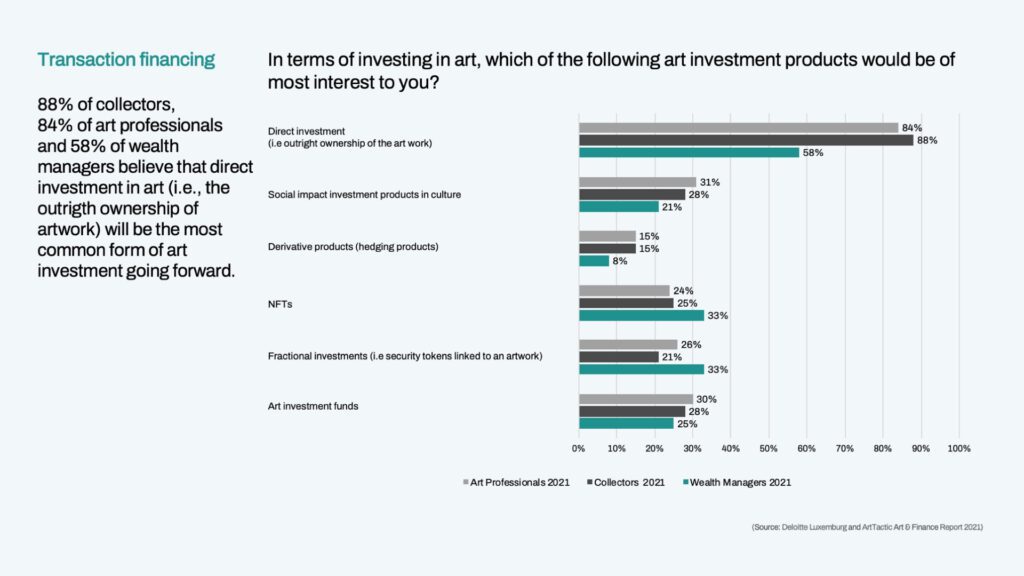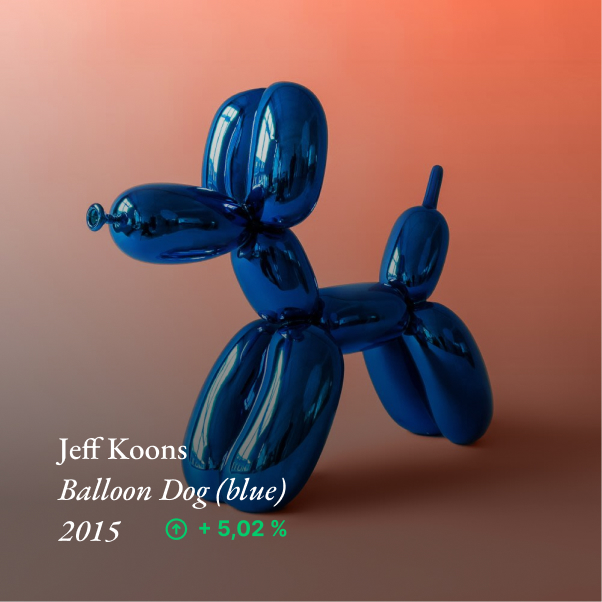Option 1
Direct Investments
Direct investments in art means acquiring artworks directly from the primary or secondary market, which requires purchasing, possessing, and managing the art. The main purpose is often focused on aesthetics, psychological and social reasons, with a secondary interest in financial returns.
Traditional forms of art can be paintings, sculptures, works on paper or prints. They are mostly sold via traditional channels, such as dealers, galleries and auction houses. Buying from these sources often has the downside of a major lack of information and transparency, along with difficulties to examine reliable comparable. Additionally, buying and selling art via traditional channels involve high intermediary costs, such as galleries and auction commissions.
Tokenization is the process of creating a digital representation of a physical asset, such as an artwork, to increase its liquidity and tradability. By tokenizing an artwork, the asset can be represented as a single token or split into multiple tokens, also known as fractionalization. In the case of single-token, one token represents full ownership of the artwork, while fractionalization allows multiple token holders to share in the profits of the artwork.
Fractionalization also enables investors to enter and trade in asset classes that were previously inaccessible due to high investment costs. By dividing the artwork into smaller fractions, investors can purchase tokens that fit their budget, making art investments more accessible to a broader audience.
Selling tokenized artworks on the blockchain can provide buyers with a secure and transparent record of their transactions. The technology can also ensure the authenticity and provenance of the artwork, providing a level of certainty that was not possible with traditional art transactions. Overall, tokenization is a powerful tool that can revolutionize the art market, making it more accessible and transparent for investors.
1 Please note that we use the term “tokenized artwork” on our platform as a means to describe the ownership of artworks in our internal system, which uses, among other things, a unique blockchain-based token. However, we currently do not offer the purchase, trade or custody of tokens themselves on our platform and a buyer of an artwork does not receive a token in its wallet (see FAQ).
If purchasing an artwork is beyond an investor’s budget or expertise, art funds help to fill in the gap. Investors can simply buy-in the whole art market, or segment of the market, by owning shares of an art index.
- Artemundi Global Fund is an international art fund management firm. Artemundi’s team has managed dozens of funds worth billions of dollars in art since 1989.
- Anthea Art Investments is a Swiss advisory boutique for investing and managing post-war and contemporary art. Anthea’s art collection management team specializes in works by established and up-and-coming artists to optimise long-term appreciation.
- The Fine Art Group is a firm that provides financial services such as appraisals and sales for fine art and jewellery investors. They offer a diversity of art investment opportunities including private accounts and pooled investment funds, as well as art finance services like advising and securing loans for collectors.
- InArt Fund is a Luxembourg based Investment Fund, which focuses on innovative art strategies by investing in global post war and contemporary art collections.
Artnet: Founded in 1989, Arnet is the leading online resource for researching, buying and selling art. In addition, Artnet tracks seven standard indices: Top 100 Artists, European Old Master, Impressionist Art, Modern Art, Post-War Art, Contemporary Art, Chinese Art and Artist Indices. The indices are based on Artnet extensive Price Database, which covered more than 1,800 auction houses and 340,000 artists with data going back to 1985. The stock is listed on the Frankfurt Stock Exchange and on XETRA.
Artsy: Founded in 2009, Artsy is one of the largest online art marketplaces. Based in the US, the platform assists and guides both new and experienced collectors to discover, buy and sell art. Based in the US with its headquarter in New York, it is a private company and completed a number of founding rounds so far.
Artmarket.com SA: Founded in 1987, Artmarket.com SA, formerly Artprice.Com SA, is a France-based company active in the art market, with a focus on fine art, antiques and design. The Company manages an online art database, gives access to fine art auction information and produces econometrics data, as well as reports upon request. Stock listed on Euronext Paris.
1stdibs: Inspired by Parisian flea markets, 1stdibs was founded in 2000 and is currently a leading online marketplace, connecting customers with sellers and makers of fine art, antique and contemporary high-end furniture, jewellery, watches, fashion, and most recently NFTs. Stock listed on the Nasdaq Stock Market.
Weng Fine Art AG: Founded in 1994 by Rüdiger K. Weng, Weng Fine Art AG is one of the leading and most profitable art trading companies in Europe. Holding four business divisions and a team of financial, art and digital experts, the company focuses on trading works by internationally renowned artists of the 20th and 21st centuries. The stock is listed on the Munich and Frankfurt Stock Exchange and on XETRA.
Option 2
Indirect Investments
Indirect investment in art is not related to the possession of artworks but involves investing in art funds or purchasing shares of companies operating in the art market. The purpose of this type of investment is purely financially driven and focuses on positive financial returns with less significance attributed to aesthetics, psychological and social goals.
Art funds, however, face various challenges that still hinder their success. Firstly, these funds mostly consist of unique artworks, which can be difficult to price without being sold. This makes it challenging to evaluate the performance of an art fund without liquidating it. Secondly, achieving particularly high returns can only be possible through investing in new artworks that experience a rapid increase in value, which comes with high risks. Conversely, purchasing low-risk unique works by famous artists may result in a lower increase in value.
“The online market continued to expand in 2021, growing by 7% to reach an estimation of $13.3 billion.”
“The online market continued to expand in 2021, growing by 7% to reach an estimation of $13.3 billion.”
Where to Buy Art?
Auction Houses
Auction Houses represent the secondary market for artworks. The most well-known, such as Sotheby’s...
Auction Houses represent the secondary market for artworks. The most well-known, such as Sotheby’s, Christie’s, Phillips, Bonhams and the Dorotheum operate both online and in-person.
When buying an artwork at an auction, one ends up paying a buyer’s premium which lies between 20% to 30% of the hammer price depending on the auction house and the value of the work.
Online Marketplaces
Fuelled by the pandemic and the overall digital shift, online marketplaces and online platforms...
Fuelled by the pandemic and the overall digital shift, online marketplaces and online platforms have grown exponentially in the past years.
On these platforms, you can buy artworks from the primary as well as from the secondary market. Examples of online marketplace are: Artnet, Artsy, 1stDibs and LiveArt.
Online Galleries
In recent years, online galleries have gained popularity and trust. While e-commerce was...
In recent years, online galleries have gained popularity and trust. While e-commerce was already steadily growing prior the onset of the pandemic, online art sales reached a record in 2020, doubling in value from 2019. Weng Contemporary (ArtXX AG), anticipated this digital development and benefitted from the shift by consolidating its online sales and presence.
Despite the return to in-presence events and gatherings, collectors and dealers are now accustomed to a higher level of digitalisation, and we can expect online sales to continue to steadily grow.
Art Dealers
Art Dealers act as either brokers or sellers on their own account and charge a corresponding markup...
Art Dealers act as either brokers or sellers on their own account and charge a corresponding markup for the transaction. They are in the business of matching a client with the perfect piece of art.
Galleries
The traditional art galleries act usually on the primary market – they sell artworks that they receive...
The traditional art galleries act usually on the primary market – they sell artworks that they receive from the original artist that have never been sold before. They curate and pre-select artworks of artists they believe might be valuable in the future. Most of the represented artists do not yet have a secondary market and are therefore difficult to resell.
Art Funds
Art Funds are structured much like other investment funds. They allow art buyers to invest in art...
Art Funds are structured much like other investment funds. They allow art buyers to invest in art by partially owning it. Securitizing artwork in this way makes investing in art more accessible and the market for the artworks’ shares more liquid.

Art Fairs
At art fairs, artworks are sold from both the primary and also the secondary market. Due to high costs...
At art fairs, artworks are sold from both the primary and also the secondary market. Due to high costs for the exhibitors and the environment, buyers at fairs in most cases pay a significantly higher price than acquiring the same directly from galleries or in auction.

Weng Fine Art Group
With its different lines of business, Weng Fine Art Group operates through multiple sales channels. Weng Fine Art...
With its different lines of business, Weng Fine Art Group operates through multiple sales channels. Weng Fine Art, in Monheim, sells unique pieces from its own inventory mainly through auction houses and dealers. Weng Contemporary, in Zug, sells its limited editions inventory via the gallery, as well as its own online shop and different online marketplaces. Finally, Weng Art Invest, sells limited editions tokens via the newly launched trading platform.
Tools to Use when Buying Art
Artnet Price Database and Artists Indices
Artnet Price Database and Artists Indices
are based on Artnet’s extensive Price Database, which covers more than 1,800 auction houses and 340,000 artists with data going back to 1985, thus providing a key resource for evaluating the value of a work and estimating what it might sell for.
Artsy’s Price Database
Artsy’s Price Database
allows collectors to freely review millions of past auction results and get a sense of the market rate for any given artist’s work coming up for sale.
ArtFacts
Artfacts
is the world’s largest online art database providing information and analyses on artists, exhibitions, institutions and the global art world landscape. The data analysis allows to draw conclusions about the market value of an artist.
Weng Art Invest
Weng Art Invest
promotes price transparency and accessibility by providing users with all previous platform’s transactions for the listed limited editions, as well as tailored investment content sheets for each artwork offered on the platform.

